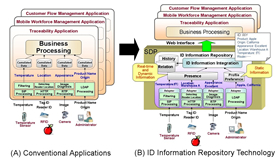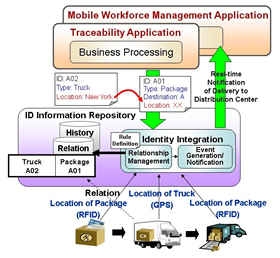Kawasaki, Japan, September 16, 2008
Fujitsu Laboratories Ltd. today announced the development of the world's first ID information repository technology for Service Delivery Platforms (SDPs) (1), which provide the core platform for delivering network services. The new technology organizes data collected by sensors and other ubiquitous-networking technologies from the frontlines of a business, making it accessible from applications at the single object or individual person level. The technology is designed to make it easy for programmers to develop applications that use this field data, even if they have no specialized background dealing with sensor or network technology.
Details of this technology will be presented at the Communications Society Conference sponsored by the Institute of Electronics, Information, and Communication Engineers (IEICE), to be held from September 16 at Meiji University's Ikuta campus located in Kawasaki, Japan.
Background
As networking technologies have grown more diverse, a variety of network services, such as fixed-line and mobile telephony as well as Internet services, have come into widespread use. In the past, each of these services was built as an independent system, making it difficult to link services across systems, for example such as delivering voicemail intended for one's landline number to one's e-mail address. There is heightened interest in SDPs, to enable the creation of a common platform for network functions to result in simpler system configurations, fewer lines of programming code, faster systems development, and greater efficiency.
In recent years, in addition to conventional network services, there has been a growing interest in new services such as services that assist in food safety, services that promote management efficiency by making employee resource allocation be visible, and services that improve business performance by tracking and analyzing the movements of customers on a retail floor. To deliver such services, which would require utilizing real-time data on individuals and objects collected on the front lines using ubiquitous networked devices equipped with temperature sensors or image sensors, the application of SDP technology is considered quite promising.
Technological Challenges
For the following reasons, it is a challenge to develop applications that will implement these services (see Figure 1, A):
 Figure 1: Technologies to integrate ID information
Figure 1: Technologies to integrate ID information
Larger View (356 KB)
- In order to connect a variety of ubiquitous sensing technologies - including cameras and RFID reader - into a system, developers require advanced knowledge of each sensor's characteristics and various network protocols (such as SIP, RTP, LDAP, RFID, etc.).
- Each application requires new programming to process, tabulate, and store the great volume and diversity of sensor data that is gathered from these sensors. This increases the number of lines of code that need to be written and slows down the development cycle.
Newly Developed Technology
Fujitsu Laboratories has developed three core technologies to resolve these issues, resulting in the world's first ID information repository technology, giving applications access to frontline information at the individual person or single object level.
For this technology, people and objects are the service targets and are referred to as "IDs," and technology that manages all forms of field data regarding these IDs is referred to as "ID information repository technology."
1. Integrated ID information, to increase programming productivity for application developers (see Figure 1, B)
Fujitsu Laboratories developed technology that integrates and systematically accumulates information on people or objects at the individual ID level, including field data that dynamically changes in real time and attribute information that undergoes relatively small changes. Because this technology can be shared among different applications, programmers do not need to write new code to process, tabulate, and store this data for each application.
Furthermore, because this technology provides a common platform for the protocols used to connect to all the various remote-sensing equipment and for processing the sensor data, developers can use the frontline data collected by employing web interfaces that are easy to program. This makes it easy to develop applications without specialized knowledge or expertise in each sensor's characteristics or networking protocols.
2. Relation management technology to improve information reusability (see Figure 2)
 Figure 2: Relational technology and event generator/notifier
Figure 2: Relational technology and event generator/notifier
Larger View (239 KB)
Fujitsu Laboratories has developed relation management technology that permits information on one object to be reused with information from another object, based on the relationship between the two objects. For example, to track the location of cargo when it is loaded on a truck, the system can use not only the RFID tag of the cargo but also the GPS data from the truck.
3. Event generator/notifier technology to reduce processor load (see Figure 2)
To detect changes in field data, the system includes a real-time event notification engine for applications. This eliminates the need for applications to poll for new data at regular intervals, thus reducing the system's processing load.
Results
This ID information repository technology enables the development of, for example an application that can gather temperature and location data on fresh foods, while the developer would not need to possess specialized knowledge of temperature sensors, RFID tags, or networking protocols.
Applying this technology to SDPs enables easy creation of a wide variety of related applications that use the collected data, such as a temperature-management application for retailers, an application to provide product information to consumers, or a freight-management application for producers.
This makes it possible to use field data to swiftly provide new services to meet increasingly diverse market needs.
Future Developments
Fujitsu Laboratories plans to conduct practical testing inside and outside of Fujitsu Laboratories to verify the technology's functionality, and a variety of different types of sensors will be used to verify the technology's performance.
![]() Phone: +81(44)754-2667
Phone: +81(44)754-2667![]() E-mail: idcontainer@ml.labs.fujitsu.com
E-mail: idcontainer@ml.labs.fujitsu.com
